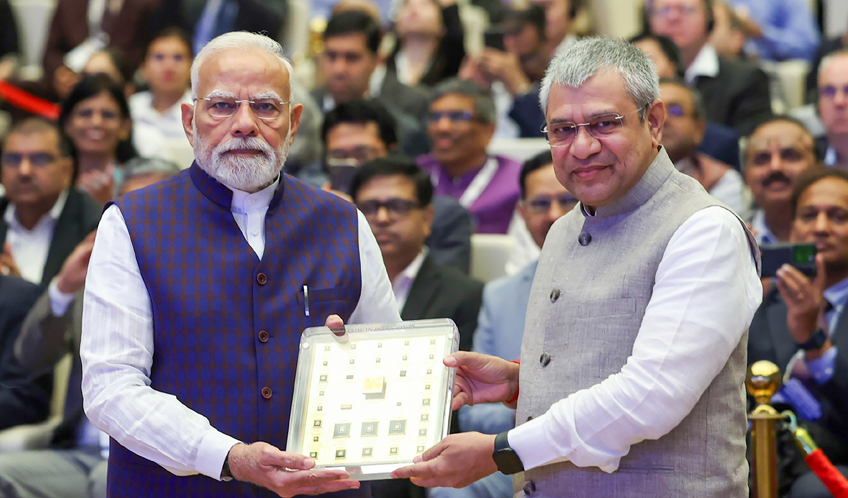Semiconductors, those tiny chips no larger than a fingernail, now stand at the heart of global economic security and strategic independence. As digitalisation and automation sweep the world, these components drive key systems in healthcare, transport, communication, defence and space exploration. The race to produce advanced semiconductors has turned into a high-stakes contest, much like the Cold War nuclear arms buildup, with nations vying for dominance in chip manufacturing. India, long on the sidelines, is now stepping up its game in the semiconductor sector. Prime Minister Narendra Modi, while inaugurating SEMICON India 2025 in New Delhi on September 2, firmly stated that India aims to grab a major slice of the global semiconductor market, projected to hit USD 1 trillion soon. PM Modi categorically said how the India Semiconductor Mission (ISM), launched in 2021, has moved the country from mere plans to concrete action in just four years. This event, organised by ISM under the Ministry of Electronics and Information Technology and global semiconductor industry association SEMI, draws global players to position India as a hub for semiconductor innovation and production.
‘Vikram’ Powers Viksit Bharat
The pioneer efforts made by the BJP-led ruling establishment at the Centre include a Rs 76,000 crore Production Linked Incentive (PLI) scheme for semiconductors, with nearly Rs 65,000 crore already pledged. This has drawn investments and spurred local efforts. A key milestone is the Vikram microprocessor, India’s first fully home-grown 32-bit chip, built by the Indian Space Research Organisation (ISRO). Designed for tough launch vehicle environments, it marks a leap in indigenous tech for space applications. Another breakthrough comes from CG Semi, set to release the first ‘Made in India’ semiconductor chip from its Outsourced Semiconductor Assembly and Test (OSAT) facility in Sanand, Gujarat. The Modi government greenlit this unit in 2023, and commercial output is slated for 2026-27.
Missed The Boat
Yet, India’s semiconductor story carries the weight of missed chances over decades. From the 1960s to the early 2000s, global firms like Fairchild and Intel showed keen interest in setting up plants here. But restrictive policies, slow bureaucracy and lack of timely decisions drove them away. Investments flowed instead to China and Vietnam, helping those nations build robust chip industries. Had policymakers acted swiftly, India could have stood alongside Taiwan, China and South Korea as a semiconductor powerhouse. Past attempts, like policies in 2007 and 2013, also fell short due to similar hurdles. In the 1980s, under former Prime Minister Rajiv Gandhi, some momentum built with the Semiconductor Complex Limited in Chandigarh, but it lagged behind global advances.
Today, the global semiconductor landscape remains skewed. Taiwan and China account for about 75 per cent of world production, with Taiwan’s TSMC alone holding 64 per cent of the foundry market. The United States contributes around 12 per cent in advanced segments, bolstered by the CHIPS Act. Malaysia, the seventh-largest exporter, excels in assembly, packaging and testing, and eyes growth in design and equipment. Geopolitical tensions, including US-China rivalry, are prompting supply chain shifts away from Taiwan and China, creating openings for India.
Future Resilience
India’s current push taps into this trend. The India Semiconductor Mission has cleared four new projects recently, including units in Odisha and Gujarat, drawing over half a trillion dollars in private investments. At SEMICON India 2025, 12 memorandums of understanding were signed for product development and partnerships. Firms like ASML are engaging, signalling confidence in India’s ecosystem. The second phase of ISM will focus on components and raw materials to build a full supply chain.
In the years ahead, semiconductors will play a pivotal role in shaping global power dynamics, influencing everything from economic strength to technological supremacy. India’s determined push towards Atmanirbhar chip manufacturing is set to reduce dependence on imports, strengthen strategic autonomy, and drive robust economic growth. With the global semiconductor market projected to reach USD 701 billion by the end of 2025, India’s bold initiatives, backed by substantial investments and a clear vision, are laying the foundation for a thriving domestic industry. This marks a turning point, transforming decades of missed opportunities into a promising future. As Prime Minister Narendra Modi aptly said, “India does not wait for opportunities; we create them.” This ethos drives the nation’s semiconductor journey, positioning it as a key player in the global chip race and paving the way for a stronger, self-reliant Viksit Bharat.















